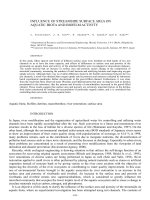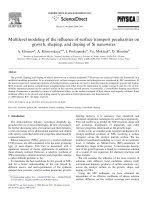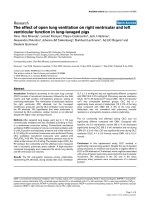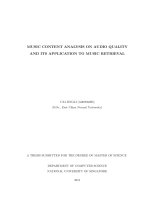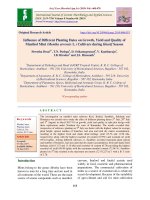tiểu luận research about the influence of music content marketing on user satisfaction and intention to use in the metaverse
Bạn đang xem bản rút gọn của tài liệu. Xem và tải ngay bản đầy đủ của tài liệu tại đây (3.04 MB, 30 trang )
<span class="text_page_counter">Trang 2</span><div class="page_container" data-page="2">
In today's global market, which is experiencing a downturn due to reduced in-personinteractions, the emergence of the metaverse offers a new avenue for growth. This studyseeks to establish a framework for evaluating the effectiveness of metaverse-based marketingstrategies for content creators and marketers. Through an analysis of various factors such asseamlessness, presence, interoperability, concurrence, and economic flow within themetaverse, along with customer satisfaction and purchase intention, all 11 hypotheses werefound to be supported. In conclusion, this research highlights the potential value of musiccontent marketing within the metaverse, as evidenced by the metaverse SPICE model.
Keywords: metaverse; music content; metaverse marketing; SPICE model.
</div><span class="text_page_counter">Trang 4</span><div class="page_container" data-page="4"><b>I.Introduction and Background</b>
<b>1. Important of research </b>
The COVID-19 pandemic has fundamentally reshaped our lives, ushering in a"contactless" era. This has led to a surge in telecommunication, remote work, and virtualexperiences. The metaverse, a recently emerged platform powered by 5G, advanced graphics,and cutting-edge displays, presents a new paradigm for this era. This technology offers aunique blend of virtual experiences and high connectivity, unbound by time and space.However, the metaverse is still in its early stages, and its effectiveness as a marketing toolremains largely unexplored. This research aims to bridge this gap by investigating usersatisfaction with music content in the metaverse. By analyzing this data, we hope tounderstand the impact of music content marketing on consumer satisfaction and purchaseintention within the metaverse. This will provide valuable insights for content creators andmarketers seeking to develop successful metaverse marketing strategies in the post-pandemicera.
<b>2. Scope of research </b>
This research focuses on “consumer satisfaction” and “purchase intention”. Thisresearch is not limited to any type of music and using two questionnaires Vietnamese andEnglish.
Considering the time and size of research, we use two factors (consumer satisfactionand purchase intention) in many experiences from quantitative research and literature reviewto build the framework and testing hypothesis.
The target audience is Vietnamese people, who use the metaverse, above 20 yearsold.
<b>3. Research problem/question </b>
In quantitative research, the result helps to answer the question: How does MusicContent Marketing affect Consumer Satisfaction and Purchase Intention? Based on the resultof quantitative research, in next step this research tries to answer these questions:
How does the SPICE Model for Music Content Marketing influence ConsumerSatisfaction?
How does the SPICE Model for Music Content Marketing influence Purchase
<b>Too long to read onyour phone? Save</b>
to read later onyour computer
Save to a Studylist
</div><span class="text_page_counter">Trang 5</span><div class="page_container" data-page="5">Content Marketing have a significant positive effect on Purchase Intention?
<b>4. Aims and Objectives </b>
This study’s aim is to provide a framework for content creators and marketers toverify the effectiveness of metaverse marketing.
This study’s objective is to examine the influence of the music content marketingSPICE model factors and Consumer satisfaction and purchase intentions in the metaversethrough theoretical considerations and reviews of previous studies.
<b>5. Literature review</b>
<b>Applicability of Existing Marketing Tools</b>
Davis et al. suggest that existing marketing tools used on traditional platforms can beadapted for the metaverse due to similarities in user behavior.
<b>Marketing Strategies in the Post-COVID Era</b>
Wamba et al. analyze big data to demonstrate the suitability of "untact" marketingstrategies for promoting performing arts and cultural content in the post-COVID era. Thisfinding aligns with the metaverse's potential for contactless experiences.
<b>SPICE Factors for Metaverse Marketing</b>
Studies by Yüksel et al., Lee et al., and You et al. propose SPICE factors(Continuity, Presence, Interactivity, Customization, and Engagement) as crucial elements foreffective marketing within the metaverse environment.
<b>Music Content Marketing and Purchase Intention</b>
Hampe and Schwabe explore the connection between music content marketing andpurchase intention in live commerce settings, drawing on research by Lu and Chen. Thissuggests a potential link between music marketing in the metaverse and user purchasingbehavior.
<b>Additional Factors Influencing User Behavior</b>
Studies on consumer preferences highlight interoperability, simultaneity, andeconomic flow as important factors affecting user behavior in online environments, includingpurchase intention and continued use. These factors may also hold relevance for themetaverse.
</div><span class="text_page_counter">Trang 6</span><div class="page_container" data-page="6">content in attracting and retaining subscribers on music platforms like YouTube. Thishighlights the need for compelling music content within the metaverse to maximize theeffectiveness of marketing strategies.
<b>6. Research model and Hypothesis</b>
H1. The metaverse SPICE model for music content marketing has a significanteffect on consumer satisfaction.
H1-1. Continuity has a significant positive effect on Consumer satisfaction.H1-2. Sense of presence has a significant positive effect on Consumer satisfaction.H1-3. Interoperability has a significant positive effect on Consumer satisfaction.H1-4. Concurrence has a significant positive effect on Consumer satisfaction.H1-5. Economic flow has a significant positive effect on Consumer satisfaction.H2. The metaverse SPICE model for music content marketing has a significanteffect on purchase intention.
H2-1. Continuity has a significant positive effect on purchase intention.H2-2. Sense of presence has a significant positive effect on purchase intention.H2-3. Interoperability has a significant positive effect on purchase intention.H2-4. Concurrence has a significant positive effect on purchase intention.
</div><span class="text_page_counter">Trang 7</span><div class="page_container" data-page="7">marketing has a significant effect on purchase intention.
This research consisted of several steps. The first step was to selectscales to measure the research model’s components that span the contrastdomain and provide indicators of engagement. Second step is to make aquestionnaire, which is an online questionnaire. After collecting data, theresearcher coded the questionnaire in the coding book. The final step was totest the research hypothesis and model.
<b>1. Methodological considerations and assumptions</b>
This research is quantitative research using questionnaires to collect the data.This research aims to find the relationship among components, so that descriptiveresearch design is suitable with this aim.
<b>Table 1: Definition and method of measurement of components and</b>
</div><span class="text_page_counter">Trang 8</span><div class="page_container" data-page="8"><b>measurementSeamlessness</b> Seamlessness is a continuous
connection between various experienceson a single platform, which means that even when a specific character is connected to a previous situation, it can continue the experience without disruption by retaining actions or experiences on the platform
3 indicators adopting from
MinKyung, L., RakGun, H. (5 April 2022)
situation in which users can perceive it both spatially and socially, without any physical contact
3 indicators adopting from MinKyung, L., RakGun, H. (5 April 2022)
<b>Interoperability</b> Interoperability is the property of interlocking data
and information between the real world and the metaverse
3 indicators adopting from
MinKyung, L., RakGun, H. (5 April
</div><span class="text_page_counter">Trang 9</span><div class="page_container" data-page="9"><b>Concurrence</b> Concurrence is defined as an environment in which multiple users aresimultaneously active and can have various experiences within 1 m.
adopting from
MinKyung, L., RakGun, H. (5 April 2022)
<b>Economy Flow</b> Reflect the creation, transformation, exchange, transfer, or extinction of economic value; they involve changes in the volume, composition, or value of a unit's assets,liabilities, and net worth.
3 indicators adopting from
MinKyung, L., RakGun, H. (5 April 2022)
<b>Purchase Intention</b> Purchase Intention is the tendency of consumers to buy a brand or take actions related to purchases thatare measured by the level of possibilityof consumers to make purchases
3 indicators adopting from
MinKyung, L., RakGun, H. (5 April 2022)
<b>Consumer Satisfaction</b>
Consumer satisfaction is the tendency to take action or respond to possibilities and thus measure satisfaction on the platform by the willingness of the user to continue using it or recommend it to others.
4 indicators adopting from
MinKyung, L., RakGun, H. (5 April 2022)
The research’ respondent answered all measurement items according to the 5point likert scale (1- strongly disagree to 5- strongly agree). The questionnaireincludes 22 indicators of 7 components, not including the indicators aboutrespondents’ social demographics.
<b>2. Sample considerations</b>
Hair, J. F., Black, W. C., Babin, B. J., Anderson, R. E., & Tatham (2006)suggested that the size of the sample needs at least 5 times of indicators if using
</div><span class="text_page_counter">Trang 10</span><div class="page_container" data-page="10">provide sufficient statistical power for data analysis
(Hoe, 2008). This research contains 22 items, so that the size of the samplehas at least 110 questionnaires. This research collected 200 respondents, so that it isenough for analyzing.
<b>3. Data collection and framework, and analytical considerations</b>
Data of this research is collected through online surveys that avoid missing dataerrors. The total sample size is 200. The majority of respondents fall into the 20-30 agegroup, comprising 47.5% of the sample, the 30-40 age group and older than 40 groupaccount for 35.5% and 17.0% of the sample, respectively. The sample is nearly evenly splitbetween male and female respondents, with males representing 57% and females 43%. Themajority of respondents have a university education level accounting for 48.5%. Themajority of respondents whose employment status is already employed, accounting for53.0% .Finally, Most respondents have salaries from 10 million to 20 million VND,accounting for 42.0%.
<b>Table 2: Characteristics of respondents (N=200)</b>
Percentage(%)Age
</div><span class="text_page_counter">Trang 11</span><div class="page_container" data-page="11">Table 3 shows the frequency of 22 items of 7 factors in this research.
<b>Table 3: The descriptive result of items</b>
A1 It provides an experience with continuity 200 4.01 4.00 1.020
A2 The continuity is memorable 200 3.84 4.00 1.189
A3 The interest in music content increaseddue to the experience of the continuityelement
</div><span class="text_page_counter">Trang 12</span><div class="page_container" data-page="12">Interest in music content has increased dueto the experience of elements of presence
C1 It provides a working environment 200 4.07 4.00 0.998
C2 The interactive experience is interesting 200 3.86 4.00 1.047
C3 Interoperable experiences lead to fandommemberships, etc.
</div><span class="text_page_counter">Trang 13</span><div class="page_container" data-page="13">The possibility of purchasing content-related products has increased
music-F3 It convinces you to purchase the artist’smerchandise
200 3.81 4.00 0.958
<b>Consumer Satisfaction</b>
G1 Sensitivity toward the artist rises 200 3.95 4.00 0.981
G2 I acquire a lot of information related tomusic content
</div><span class="text_page_counter">Trang 14</span><div class="page_container" data-page="14">Concurrence (D) 0.700
Purchase Intention (F) 0.710
Consumer Satisfaction (G) 0.792
</div><span class="text_page_counter">Trang 15</span><div class="page_container" data-page="15">Seamlessness/Presence/Interoperability/Concurrence/Economy Flow/PurchaseIntention/Consumer Satisfaction
Seamlessness/Presence/Interoperability/Concurrence/Economy Flow/PurchaseIntention/Consumer Satisfaction
All variables: Sig > alpha = 0.05 → Failed to reject H0 → Accepted
Seamlessness/Presence/Interoperability/Concurrence/EconomyFlow/Purchase Intention/Consumer Satisfaction
</div><span class="text_page_counter">Trang 16</span><div class="page_container" data-page="16">Seamlessness/Presence/Interoperability/Concurrence/Economy Flow/PurchaseIntention/Consumer Satisfaction
Seamlessness/Presence/Interoperability/Concurrence/Economy Flow/PurchaseIntention/Consumer Satisfaction
All variables: Sig > alpha = 0.05 → Failed to reject H0 → Accepted
Seamlessness/Presence/Interoperability/Concurrence/EconomyFlow/Purchase Intention/Consumer Satisfaction
</div><span class="text_page_counter">Trang 17</span><div class="page_container" data-page="17">Seamlessness/Presence/Interoperability/Concurrence/Economy Flow/PurchaseIntention/Consumer Satisfaction
Seamlessness/Presence/Interoperability/Concurrence/Economy Flow/PurchaseIntention/Consumer Satisfaction
All variables: Sig > alpha = 0.05 → Failed to reject H0 → Accepted
Seamlessness/Presence/Interoperability/Concurrence/EconomyFlow/Purchase Intention/Consumer Satisfaction
</div><span class="text_page_counter">Trang 18</span><div class="page_container" data-page="18">Seamlessness/Presence/Interoperability/Concurrence/Economy Flow/PurchaseIntention/Consumer Satisfaction
Seamlessness/Presence/Interoperability/Concurrence/Economy Flow/PurchaseIntention/Consumer Satisfaction
All variables: Sig > alpha = 0.05 → Failed to reject H0 → Accepted
Seamlessness/Presence/Interoperability/Concurrence/EconomyFlow/Purchase Intention/Consumer Satisfaction
</div><span class="text_page_counter">Trang 19</span><div class="page_container" data-page="19">Seamlessness/Presence/Interoperability/Concurrence/Economy Flow/PurchaseIntention/Consumer Satisfaction
Seamlessness/Presence/Interoperability/Concurrence/Economy Flow/PurchaseIntention/Consumer Satisfaction
All variables: Sig > alpha = 0.05 → Failed to reject H0 → Accepted
Seamlessness/Presence/Interoperability/Concurrence/EconomyFlow/Purchase Intention/Consumer Satisfaction
<b>4. Regression Analysis</b>
Table below shows the final result of testing hypothesis, all of hypotheses were
</div><span class="text_page_counter">Trang 20</span><div class="page_container" data-page="20">Continuity => Consumersatisfaction.
Presence => Consumer satisfaction
Interoperability => Consumer satisfaction
Concurrence => Consumer satisfaction
Economic flow => Consumer satisfaction
Continuity => purchase intention.
Presence => purchase intention.
Interoperability => purchase intention.
Concurrence => purchase intention.
Economic flow => purchase intention.
H3.
Consumer satisfaction => Purchase intention
SupportedThe table shows that hypotheses H1-1 (b=0.297, p=0.000), H1-2 (0.549, p=0.000),H1-3 (b=0.399, p =0.000), H1-4 (b=0.630, p=0.000) and H1-5 (b=0.986, p =0.000) are
</div><span class="text_page_counter">Trang 21</span><div class="page_container" data-page="21">function of Consumer satisfaction:
<b>Consumer Satisfaction = 0.283 - 0.006*S - 0.033*P + 0.048*I + 0.021*C +0.907*E + ei</b>
The table shows that hypotheses H2-1 (b=0.393, p =0.000), H2-2 (b=0.610,p=0.000), H2-3 (b=0.518,p=0.000), H2-4 (b=0.705, p=0.000) and H2-5 (b=0.690, p=0.000)are accepted. It means all Seamlessness, Presence, Interoperability, Concurrence andEconomy Flow lead to Purchase Intention. From this result, the research provides themathematical function of Purchase Intention
<b>Purchase Intention = 0.599 - 0.090*S + 0.094*P - 0.197*I + 0.314*C + 0.332*E +ei</b>
</div><span class="text_page_counter">Trang 22</span><div class="page_container" data-page="22">purchase intention. According to the result, H3 (b=0.698, p=0.000) was supported, so we figured out the equation:
<b>Purchase Intention = 1.218 + 0.681*Customer Satisfaction</b> +<b> ei</b>
</div><span class="text_page_counter">Trang 23</span><div class="page_container" data-page="23">Firstly, this research found that Consumer Satisfaction has a strong relationship withthe dimension of Economy Flow because Economy Flow explains most of ConsumerSatisfaction (R2 = 0.937 = 93.7%), other independent variables only explain little ofdependent variables. All independent variables have a positive impact on two dependentvariables (Consumer Satisfaction and Purchase Intention).
Seamlessness: Users generally found the experience seamless (Means = 4.00).There's some variation in memorability (Means = 3.84). The impact on music content interestis moderate and varied (Means = 3.86).
Presence: Similar to seamlessness, users found the experience to have a moderatesense of reality (Means = 3.61). However, memorability of this aspect is higher (Means =3.88). The impact on music content interest seems positive but slightly higher thanseamlessness (Means = 3.93).
Interoperability: Users felt the experience provided a working environment (Means= 4.07). However, the interactive experience’s interestingness is moderate (Means = 3.86).There's a possibility that interoperability might lead to further engagement (Means = 3.87).
Concurrency: The experience seems to achieve concurrency (Means = 4.07).Memorability of the simultaneous aspect is moderate (Means = 3.82). The impact on musiccontent interest is positive (Means = 3.96).
Economy Flow: Users found it aligned with economic flow elements (Means = 3.95)and connectable to their economic factors (Mean 3.98). Moreover, users found that there is anactual economic action to purchase music content (Means = 3.88).
Purchase Intention: Users generally reported increased interest in music content andrelated products (Means = 4.00). The possibility of purchasing also increased (Means = 3.97).However, the element's influence on convincing users to buy merchandise seems moderate(Means = 3.81).
Consumer Satisfaction: Users reported increased artist sensitivity (Means = 3.95)and information gain (Means = 3.98). There's also a desire to participate in events due to theexperience (Means = 3.88). Interestingly, the experience might be becoming a standard formusic content selection (Means = 4.10).
This study identified several areas for further investigation to enhance userexperience and marketing effectiveness in the metaverse music content. Firstly, while users
</div>